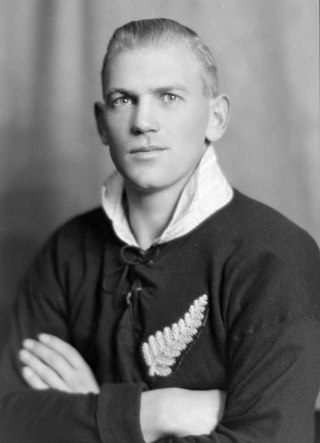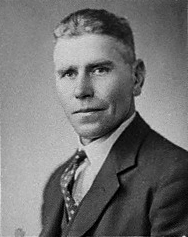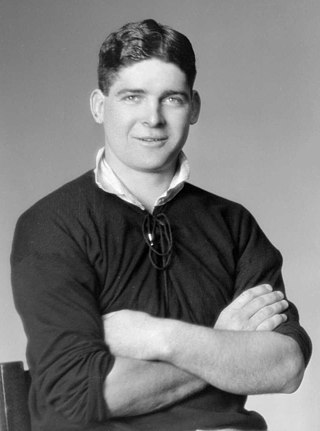Related Research Articles

Robert Semple was a union leader and later Minister of Public Works for the first Labour Government of New Zealand. He is also known for creating the Bob Semple tank.

Wellington College, is a state-run boys secondary school in Wellington, New Zealand. It is situated on 12 hectares of green belt land in the suburb of Mount Victoria, in the vicinity of the Basin Reserve and Government House. The school was founded in 1867 through a deed of endowment from Sir George Grey, the then Governor of New Zealand.

Eric William Thomas Tindill was a New Zealand sportsman. Tindill held a number of unique records: he was the oldest ever Test cricketer at the time of his death, the only person to play Tests for New Zealand in both cricket and rugby union, and the only person ever to play Tests in both sports, referee a rugby union Test, and umpire a cricket Test: a unique "double-double".

Alexander Malcolm Matheson was a New Zealand cricketer who played in two Test matches, the Fourth Test of New Zealand's initial Test series, against England in 1929–30, and, when he toured England with the New Zealanders in 1931, the rain-ruined Third Test.
The following lists events that happened during 1944 in New Zealand.

Robert McKeen was a New Zealand politician of the Labour Party. He was Speaker of the House of Representatives.

Charles Henry Chapman was a New Zealand unionist and politician of the Labour Party and various predecessor parties.

Ronald Morrison Barclay was a New Zealand politician of the Labour Party.

Josiah Ralph Hanan, known as Ralph Hanan, was a New Zealand politician of the National Party. He was Mayor of Invercargill and then represented the Invercargill electorate in Parliament, following in his uncle Josiah Hanan's footsteps. He served in World War II and his injuries ultimately caused his death at age 60. He is best remembered for the abolition of the death penalty, which had been suspended by the Labour Party, but which National was to reintroduce. As Minister of Justice, it was Hanan's role to introduce the legislation to Parliament, but he convinced enough of his party colleagues to vote with the opposition and thus abolished the death penalty in New Zealand.

Edward Arthur "Ben" Waters was a New Zealand rower who won two medals at the 1930 British Empire Games. He later unsuccessfully stood as a Labour parliamentary candidate at several elections.

Arnold Thomas Anderson was a New Zealand track and field athlete, navy officier and school teacher. He won a bronze medal for his country at the 1938 British Empire Games, joined the Royal Navy in World War II and then taught Latin and French at King's High School in New Zealand.

Edwin Purcell Meachen was a New Zealand politician of the Labour Party.
Cecil Albert Blazey, generally known as Ces Blazey, was a New Zealand rugby union and athletics administrator. During the controversial 1981 Springbok tour he was the NZRFU chairman and spokesman. He has been described as "one of the most outstanding sports administrators New Zealand has seen" and was "regarded internationally as the leading authority on the laws of the game".

Waikumete Cemetery, originally Waikomiti Cemetery, is New Zealand's largest cemetery. It occupies a site of 108 hectares in Glen Eden, Auckland, and also contains a crematorium in the south-west corner of the cemetery.

Raymond Alfred Dalton was a New Zealand rugby union player. A prop, Dalton represented Wellington and Otago at a provincial level, and was a member of the New Zealand national side, the All Blacks, between 1947 and 1949. He played 20 matches—three as captain—for the All Blacks, including two internationals.
James Douglas Mackay was a New Zealand rugby union player. A wing three-quarter, Mackay represented Wellington at a provincial level, and was a member of the New Zealand national side, the All Blacks, in 1928. He played two matches for the All Blacks, scoring four tries, but did not appear in any internationals.
Albert William "Snow" Bowman was a New Zealand rugby union player. A flanker, Bowman represented Hawke's Bay, Wellington, and Nelson at a provincial level, and also appeared in services teams during World War II. He was a member of the New Zealand national side, the All Blacks, on their 1938 tour of Australia. playing in six matches including three internationals.

Jack Finlay was a New Zealand rugby union player. A versatile player, Finlay turned out in the forwards for his club but usually as a first or second five eighth at provincial level for Manawatu. He played just one match for the New Zealand national side, the All Blacks, as a Number 8 in the first test against the touring Australian team at Carisbrook in 1946, in which he scored a try.
Mayzod Elizabeth Hodgson was a New Zealand diver who represented her country at the 1950 British Empire Games.

Tristan Freitas Hegglun was a New Zealand rower, rugby union player, and local-body politician. He rowed for his country at the 1950 British Empire Games, and won two national rowing titles. A front-row forward and lock, he played provincial rugby for both Wellington and Marlborough, and was involved in services matches during World War II. He later served as a Blenheim borough councillor.
References
- ↑ "Thomas Clarence Morrison". Online Cenotaph. Auckland War Memorial Museum. Retrieved 31 August 2015.
- ↑ "New Zealand, World War II appointments, promotions, transfers and resignations, 1939–1945" . Ancestry.com Operations. 2014. Retrieved 31 August 2015.
- ↑ Arthur Swan & Arthur Carman (ed.). The Rugby Almanack of New Zealand 1946. Sporting Publications, Wellington.
- ↑ Knight, Lindsay. "Tom Morrison". New Zealand Rugby Union. Retrieved 31 August 2015.
- ↑ "No. 44486". The London Gazette (3rd supplement). 1 January 1968. p. 42.
- ↑ "Cemeteries search (cremation)". Wellington City Council. Retrieved 31 August 2015.[ dead link ]
- ↑ "Cemeteries search (burial)". Wellington City Council. 12 July 2012. Retrieved 31 August 2015.[ dead link ]